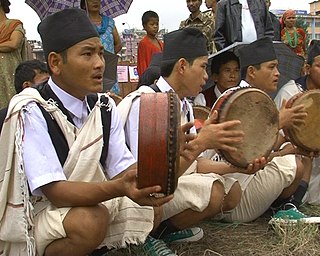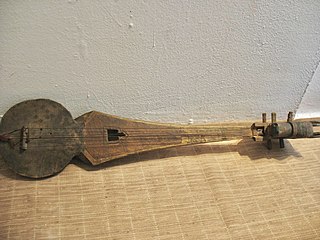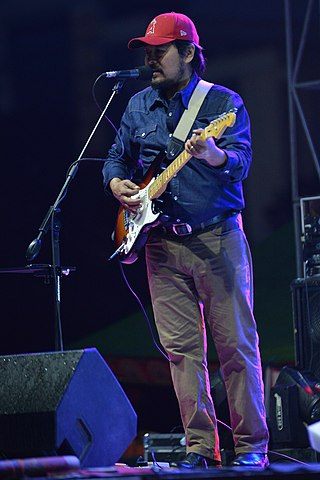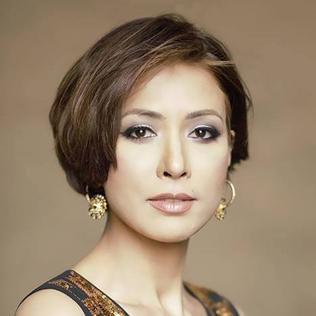Music of Nepal refers to the various musical genres played and listened to in Nepal. With more than fifty ethnic groups in Nepal, the country's music is highly diverse. Genres like Tamang Selo, Chyabrung, Dohori, Adhunik Geet, Bhajan, Filmi music, Ghazal, Classical music, songs and Ratna music are widely played and popular, but many other less common genres are yet to be cataloged. Western musical genres like Rock, Metal, Hip-Hop, Rap, R&B also regularly feature on the Nepalese music charts. Most of the country's musical bands are based in the Kathmandu valley. Musical genres from Tibet and India have greatly influenced Nepalese music.

Tamang, are a Tibeto-Burman ethnic group of Nepal, Southern Bhutan and North-east India. The Nepalese Tamang people constituted 5.6% of the population at over 1.3 million in 2001, increasing to 1,539,830 in the 2011 census; the 2021 census reported 1,639,866 Tamang. The Nepali Tamangs are concentrated in the central hilly and Himalayan regions of Nepal. Indian Tamangs are found in significant numbers in the state of Sikkim and the districts of Darjeeling and Kalimpong in West Bengal state. Bhutanese Tamangs are native to various districts in the southern foothills of the Kingdom of Bhutan. Such districts include the Tsirang District, the Dagana District, the Samtse District, the Chukha District, the Sarpang District and the Samdrup Jongkhar District. Tamang language is the fifth most-spoken language in Nepal.

Indian folk music is diverse because of India's enormous cultural and traditional diversity. It is sung in various languages and dialects throughout the length and breadth of this vast nation and exported to different parts of the world owing to migration.

A damphu, or damfoo, is a percussion instrument similar to a large tambourine. This instrument is used by the Tamang people of Nepal to play the melodious Tamang Selo. According to folklore Damphu was invented by Peng Dorje, a Tamang King and named it after Nepal's national bird the Daphne bird. It is also played by the gurung and magar people of nepal.

The Nepali Sarangi is a Nepali folk instrument. It is a chordophone played by bowing. Traditionally in Nepal, the Sarangi was only played by people of Gandarbha or Gaine caste, who sing narrative tales and folk song, however, in present days, its popularity extends beyond the Gandharba community and is widely used and played by other caste members as well. It has also garnered much interest in other music genres, such as Nepali rock and film music. While the Sarangi has become the quintessential Gandharba instrument, its counterpart, the arbajo, which is a plucked lute, has fallen into obscurity.

The Tungna is a plucked string instrument from the Northern Himalayan region: Nepal, Tibet, Sikkim and Bhutan. It is made from a single piece of carved wood. The front hollow body is covered with stretched animal skin on which the 'bridge' sits. The Tungna has four strings which is anchored to the keys and body at both ends and the 'bridge' acts as a cantilever thus maintaining the tension of the strings.

Adrian Pradhan is a Nepalese vocalist, composer and songwriter. He was born and raised in Kalimpong, West Bengal, India. He is the lead member of the Nepali rock band 1974 AD. Pradhan was the lead vocalist of the band until March 2015, after which he was replaced by Rohit John Chhetri. Pradhan reunited with the band in 2019 and has been associated with 1974 AD since.

Hira Devi Waiba was an Indian folk singer in the Nepali-language and is hailed as the pioneer of Nepali folk songs.

The arbajo is a Nepali four-string lute used as a rhythm instrument. It is the traditional instrument of the Gandarbha caste of musical performers, and is considered a companion to the Nepali sarangi. The Gandarbhas consider the aarbajo to be the "male instrument", the sarangi the "female." The aarbajo is used less than in the past, and been replaced by the sarangi, which was considered in 1999 to have superseded the aarbajo in common use.

Seturam Shrestha (1891-1941) was a Nepalese musician, singer and composer. He was an important figure in the development of modern music in Nepal at the beginning of the 20th century, and has been hailed as an Ustad. In addition to songs of love, Seturam sang songs with messages of social reform.
Resham Firiri is a traditional Nepali folk song, composed by Buddhi Pariyar and originally performed by Sunder Shrestha and Dwarika Lal Joshi in 1969. Due to sudden rise in popularity, it became one of the most widely known and performed songs in Nepal. It is often played on the sarangi, a native instrument, as street music.

Folk Roots is the second studio album by Nepali folk band Kutumba. It is contains instrumentals of old Nepali songs and Nepali folk songs which are covered, remastered and improvised by the band. The album is produced and marketed by SAC Music International. It is one of Kutumba's most famous albums that introduces old songs to the new young generation. The band has improvised these old songs and produced it in better quality preserving these immortal Nepali songs for the new generation. The album features a 9:00 minutes long instrumental of "Asarai Mahinama" and instrumentals of other famous folk songs like "Sindhuli Gadi", "Ful Ko Thunga" and others. As their name, Kutumba is all about bringing together traditional folk tunes and instruments with new and improvised sounds and ideas.
Night is a new-school folk band from Nepal. The band is known for using traditional Nepali instruments in its songs. It aims to reintroduce traditional instruments of Nepal to the modern generation of Nepali-speaking audiences.

Navneet Aditya Waiba is an Indian singer who primarily sings in Nepali-language and the daughter of the late Hira Devi Waiba, the pioneer of Nepali folk music. Navneet and younger brother Satya Aditya Waiba (producer/manager) attempt to maintain the essence of the folk music genre by producing authentic traditional Nepali folk songs using traditional musical instruments.

Tamang Selo is a genre of Nepali folk song sung by the Tamang people of Nepal and is widely popular among the Nepali-speaking community in Nepal, in India, and around the world. It is usually accompanied by the Tamang instruments: Damphu, Madal and Tungna. A Selo could be very catchy and lively or slow and melodious and is usually sung to express love, sorrow and stories of day to day life.

Ama Lai Shraddhanjali is a Nepali folk music album by Navneet Aditya Waiba and Satya Waiba, released on 3 November 2017 in Patan Museum, Kathmandu, Nepal. It was released by OKListen. The album is a tribute to Legendary Nepali folk singer the late Hira Devi Waiba, Navneet and Satya's mother.

Project Sarangi is a Nepali foundation that is dedicated to the preservation and promotion of indigenous Nepali folk music craftsmanship. It provides tutorials in the playing of Nepali Sarangi and other Nepali folk instruments. Project Sarangi is based in Kathmandu, Nepal and was founded by sarangi player Kiran Nepali in 2012.

Kiran Nepali is a Nepali sarangi musician from Nepal and a member of the Nepali folk band Kutumba.















